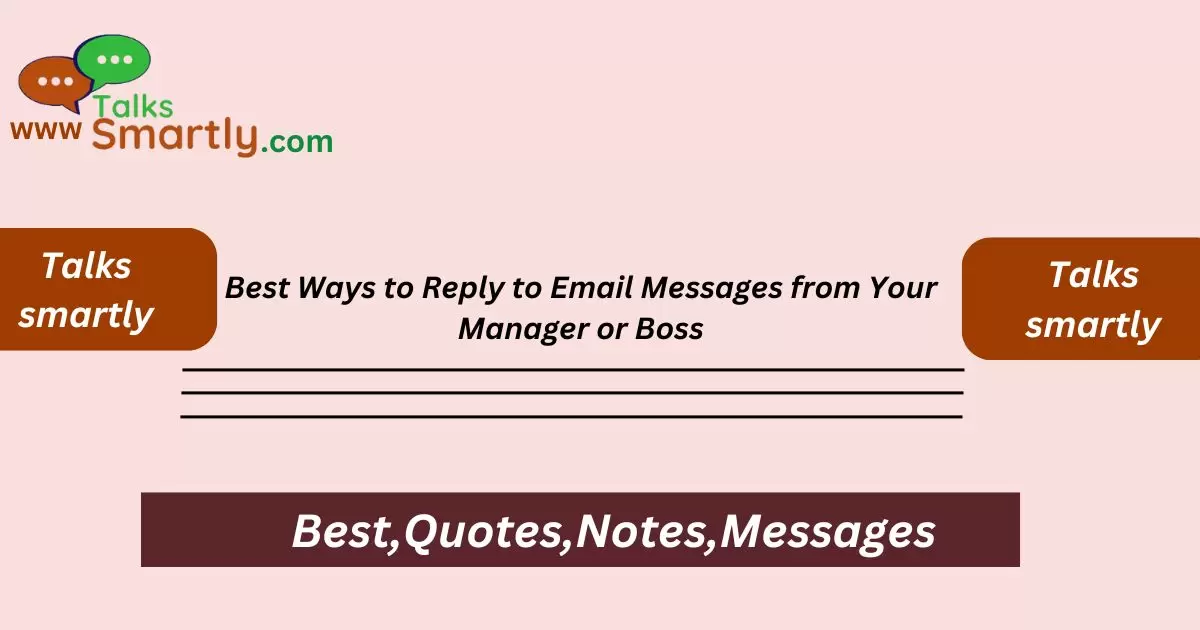Navigate professional communication with these 50+ best ways to reply to emails from your manager or boss.
Responding to email messages from your manager or boss is a crucial aspect of professional communication. It not only shows your responsiveness but also reflects your professionalism and respect for hierarchy
In this comprehensive guide, we will explore effective ways to reply to various types of email messages from your superiors, ensuring clarity, courtesy, and professionalism in every interaction.
Positive Responses to Welcome Aboard Messages
- Express Gratitude: Thank your manager sincerely for the warm welcome.
- Acknowledge the Warmth: Mention how appreciative you are of the kind welcome message.
- Highlight Excitement: Share your enthusiasm about joining the team.
- Assure Commitment: Reaffirm your dedication to contributing positively to the team.
- Emphasize Readiness: Express your readiness to embark on new challenges.
- State Professionalism: Mention your commitment to maintaining high standards of professionalism.
- Show Eagerness: Highlight your eagerness to learn from the team and grow professionally.

- Personal Touch: Share a brief personal anecdote relevant to the welcoming message.
- Encouraging Words: Offer encouraging words about working together effectively.
- Team Appreciation: Express appreciation for the team’s warm welcome.
- Future Collaboration: Mention your enthusiasm for future collaborations.
- Positive Outlook: Share your optimism about contributing to the team’s success.
- Thankful Gesture: Offer to be of help and support to the team.
- Respectful Acknowledgment: Acknowledge the warm welcome with respect.
- Warm Response: Respond warmly to the welcoming message.
- Appreciation for the Opportunity: Express your appreciation for the opportunity to work with the team.
- Readiness to Start: State your readiness to start contributing to the team.
- Positive Attitude: Share your positive attitude towards joining the team.
- Positive Feedback: Provide positive feedback on the welcoming message.
- Positive Emotions: Share your positive emotions about joining the team.
Best Replies to Welcome Aboard Messages from Your Manager
- Express Gratitude for the Warm Welcome: Thank your manager for the warm welcome message.
- Acknowledge the Kindness: Acknowledge the kindness in the welcome message from your manager.
- Express Excitement: Express your excitement about joining the team.
- Reaffirm Dedication: Reaffirm your dedication to contributing positively to the team.
- State Readiness: State your readiness to take on responsibilities.
- Commit to Professionalism: Commit to maintaining high standards of professionalism.
- Express Eagerness: Express eagerness to learn and grow with the team.
- Personal Connection: Share a personal connection relevant to the welcoming message.
- Encouraging Words: Offer encouraging words about collaboration and teamwork.
- Appreciation for the Warm Welcome: Express appreciation for the warm welcome from your manager.
- Future Collaboration: Express enthusiasm for future collaborations with your manager.
- Positive Contribution: Share your optimism about making a positive contribution to the team.
- Offer Support: Offer to support your manager and the team in achieving goals.
- Respectful Response: Respond respectfully to your manager’s welcoming message.
- Warm Reply: Reply warmly to your manager’s welcoming message.
- Thankful for the Opportunity: Express gratitude for the opportunity to work with your manager.
- Ready to Start: State your readiness to start working under your manager’s guidance.
- Positive Attitude: Share your positive attitude towards the team and your manager.
- Positive Feedback: Provide positive feedback on your manager’s welcoming message.
- Express Joy: Express joy about joining your manager’s team.
Friendly Responses to Welcoming Aboard Messages from Colleagues
- Grateful Response: Express gratitude to colleagues for the warm welcome.
- Appreciative Acknowledgment: Acknowledge the warm welcome from colleagues.
- Excitement: Share your excitement about working together with colleagues.
- Commitment to Team: Reaffirm your commitment to working effectively with the team.
- Readiness: Express readiness to collaborate and contribute to team goals.
- Professionalism: Commit to upholding professionalism in all interactions.
- Eagerness to Learn: Express eagerness to learn from colleagues and grow together.
- Personal Connection: Share a brief personal connection relevant to colleagues’ welcoming messages.
- Encouraging Words: Offer words of encouragement for productive teamwork.
- Thankful Gesture: Offer your help and support to colleagues.

- Warm Acknowledgment: Acknowledge colleagues warmly for their welcome.
- Future Collaboration: Express enthusiasm for future collaborations with colleagues.
- Positive Contribution: Share your optimism about contributing positively to the team.
- Supportive Offer: Offer support and collaboration in achieving team objectives.
- Respectful Reply: Respond respectfully to colleagues’ welcoming messages.
- Warm Response: Respond warmly to colleagues’ welcoming messages.
- Gratefulness for Opportunity: Express gratitude for the opportunity to work with colleagues.
- Readiness to Begin: State your readiness to start working with the team.
- Positive Outlook: Share a positive outlook on working with colleagues.
- Appreciative Feedback: Provide appreciative feedback on colleagues’ welcoming messages.
Conclusion
Responding to email messages, especially from managers and colleagues, is an opportunity to demonstrate professionalism, gratitude, and a positive attitude. By using these effective response strategies, you can build strong professional relationships and contribute to a productive work environment.
Remember to tailor your responses to the specific context and maintain a tone of respect and enthusiasm in all communications.












